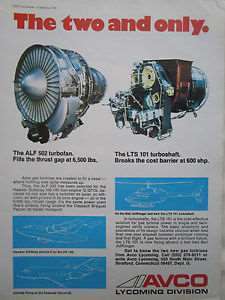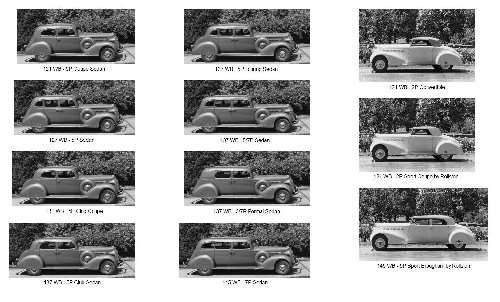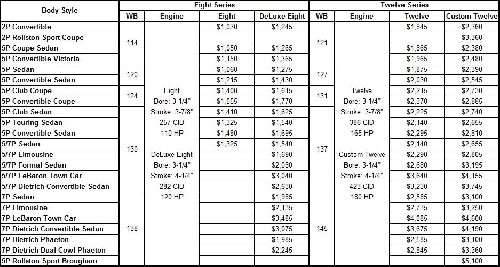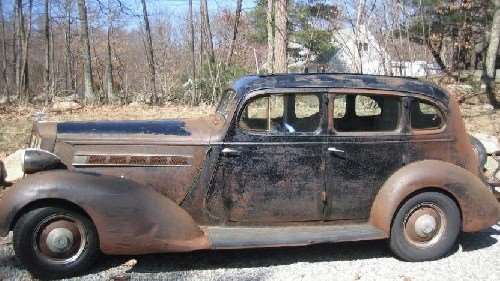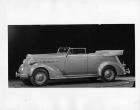|
Re: 1935 - Turning Point and What-Ifs
|
||||
|---|---|---|---|---|
|
Home away from home

|
Looks like they were ripe for a purchase. Maybe the only thing that would have stalled a deal was upcoming Cord 810, which the company would probably have been depending on its Auburn dealers to sell.
Auburn may have been for sale since 32, but, from the annual reports on this site, Packard did not have the funds to buy a going concern. To acquire Auburn in 33-34, Packard would have had to buy the Auburn and Connersville plants, the tooling, equipment and probably assume the company's liabilities. This would have run into millions. Reportedly, Hupp paid $900,000 just for the Cord 810 tooling, from a bankrupt company being liquidated. Looks like Packard did the best thing possible. People may well have not paid $1,000 for a 120 with a new, startup name they had never heard of. Packard did not have the capital to buy a going concern. By the time the Auburn name, and Stutz for that matter, were available, the 120 was well on it's way as a Packard.
Posted on: 2015/9/1 19:30
|
|||
|
||||
|
Re: 1935 - Turning Point and What-Ifs
|
||||
|---|---|---|---|---|
|
Home away from home

|
Hi Paul, Steve203 et al
With no follow-up, modernized Seniors close-on after the 120, the Pierce-Arrow 33 and 80 analogy you've described is approximately what Packard did after 1934: continued producing wonderfully crafted and elegant styled, increasingly archaic Seniors finding a diminishing market. Meantime, contemporary Chryslers, Buicks and Cadillacs moved onto newer types of technically advanced, well-crafted, somewhat smaller luxury cars to a receptive audience. Its ironic that a decade prior, it was Packard that redefined the entry-level and full-luxury segments with their efficient-to-produce Sixes and Eights. More ironically, without the success of the '20's Packard Six, Cadillac may never have introduced its direct counter LaSalle as its companion make, which became so useful to probe the lower reaches of entry-level luxury at $1,695 for the 1934 LaSalle. Two years hence, LaSalle stepped down to $1,225, clearing the way for the Cadillac Series 60 at that pricing sweet spot. And at the very sweet spot Packard where lacked any opposing series until 1939. This may seem a minor detail but it was the very opening Cadillac exploited to begin building its dominance of the volume luxury segment. Whatever else management gleaned from the 1932 Light Eight 900, they learned first that around $1,750 was definitely the new entry-level luxury price and second that they didn't know how to cost-affectively produce at car priced as such and still be profitable. Frequently the Light Eight 900 is described as a failure because it was withdrawn quickly for 1933(integrated as the 1001). On the contrary, it was only too successful, sold 40.7% of the 1932 total, badly cannabilized the 826-equivalent 901, even the 902 to a degree. Discussions leading to the development of a medium-priced were in the process, the 900 made it clear that outside expertise was needed to learn the methods for building cars to a price standard, something relatively unimportant to Packard beforehand. In order to create the integrated 120 and follow-up, old Senior-replacing 160, acceptable to both segments, sizing critical shared components for the Senior models would have been key. Of those, the cowl/front shoulder width was primary. A brief ride in the front seat of a '36 Eight impressed me how narrow that space was. Settling on 55-56" for 1935 would have been considered wide but a welcome feature, quite acceptable. In plan view, typically bodies then tapered wider through the B-pillar, then straight rearward. Rear shoulder room to match or further to 57-58" would have cast Packards as interior space leader. Lengthening by combinations of various hoods, doors and quarters, which they were quite adept doing, would have given them enough options to tailor production bodies for each price segment. To keep the differentiation enforce, applying exterior skins that had familial appearance but unique detailing for each series absolutely necessary. Visual differentiation between series would have been the overarching styling approach, as Paul has shown. It should have to had gone the typical GM and Chrysler practice one better. Those majors had shared bodies across the price segments without significant changes, only frontal and details lent a unique look for the various makes. The public had come to expected better of Packard and custom coachbuilt-style could have been their ace-in-the-hole. The medium-price 120 and the 160 would share the classic Packard radiator styling but not the actual shell. Nor would they obviously share any other components except the lower cowl. Shared internal stamping and mechanical components would amortize much of the costs. Under the hood should have been the mono-block 356 ci pulled ahead four years to achieve economies of 120 engine production methods. As it was, only the '39 Super 8 and the Lincoln Model K Twelve still held onto this outdated mult-piece method by then. With the reduced weights over the old Seniors, other chassis components could be shared with the volume 120. Although the multi-cylinder race was fading, fielding a next-generation 423 ci twelve purely for prestige sake would have been one sop to ultra-luxury that should have been accomodated. Until the advent of fully automatic transmissions, the smooth, torquey engine was the only way to accomodate the customer who preferred to eschew frequent shifting. The other benefit would be the continued practice of V-type engine technology which could have lead to a Packard V8 years before it did. And nothing re-enforced the prestige image like a twelve, even worked for the Lincoln-Zephyr, however inappropriate in its case. For chassis lengths, 119"-122" wb seems to have been the accepted standard for the $1,000-$1,200 class. Above that, 125"-130" wb apprpriate for upper medium through entry-level luxury models. Premium sedans and some livery, be they five or seven passenger, fit the 133" - 140" best. Above that was completely the province of seven passenger sedans, limousine, livery and professional. The models Paul has presented cover all those very nicely. The only proviso with accepted wheelbase lengths by class seem to be that short-wheelbase luxury cars had to be limited production sport models and long-wheelbase medium-priced makes were primarily for livery/commercial applications. In either case, they were always low-volume models. Auburn: Although it had a sporty image which might have been useful, it would have been too costly to buyout, had little in the way of modern, well-located plants as benefit. What such a purchase would have done was divert resources needed to develop their own completely new and integrated series, which could have included their own new Auburn-type sporty series. While it seems insignificant now, the very fact that Lycoming made their engines still branded Auburn as something of an 'assembled' car. Unfair, of course, but that attitude had developed in the prior decades when the market was flooded with such cars, most short-lived. The success of the volume car was so key to their very survival, they had no real choice but it be a Packard. If they still decided to move further downmarket as they did for the 115/Six/110, a newly-introduced make would have been appropriate as well as styling not shared with any Packard. Steve
Posted on: 2015/9/3 11:15
|
|||
|
.....epigram time.....
Proud 1953 Clipper Deluxe owner. Thinking about my next Packard, want a Clipper Deluxe Eight, manual shift with overdrive. |
||||
|
||||
|
Re: 1935 - Turning Point and What-Ifs
|
||||
|---|---|---|---|---|
|
Home away from home

|
Your thoughts are always appreciated, Steve.
Great point about the width especially for the front seat passengers. The '33 Silver Arrow show car was there to be studied, at least in general terms. Packard wasn't about to go to straight-through fenders but there was no mistaking what a wider I/P could do for front seat comfort and actual and perceived space. And then there was the Airflow, which would have possibly launched in time to inform Packard's cowl width strategy. Absolutely the Seniors need not have shared styling details. For the grill, the One Twenty's narrowish opening might not have even provided enough cooling air for large engines. I can visualize the '38 Senior grill and front fender appearance on these would-be '35 Seniors. Your oft-mentioned $1,750 sweet spot and Cadillac's opportunistic moves to capture it are key, as you said. And we could easily extend this discussion to what Packard should have done for 1938 or 39 to stay apace with GM and the Sixty Special. Looking at it broadly, when one adds the capital Packard spent on the '35 One Twenty, 12th Series Seniors, '37 110, '37 138-CD, 15th Series Seniors, 16th Series Seniors and '38 Six and Eight and measures this against where they came out at decades end versus Cadillac, which had caught them and were fast pulling away, one has to conclude that although Packard saved themselves, they didn't accomplish a whole lot more other than keep pace with the main of the industry. They certainly didn't reaffirm their dominance of the luxury market as they could have. Packard's problem wasn't lack of capital. Or scale. It was how the company spent its money. Of course, it's easy to look back and critique. But critique we must, if only to understand today's times and the turmoil that many OEMs face. It seems GM voluntarily put itself through a lot of pain in the Thirties, pushing itself to the point of major discomfort as it tried to re-imagine the automobile. Edsel Ford and Chrysler both showed up to play this game too. And yes, so did Packard with its FWD experiment, '32 Light Eight and '32-34 styling exercises. Then for some reason, it took its helmet off and headed for the locker room. Seems from 1935 on it didn't make the connection between saving itself and re-imagining the automobile. GM did, and let Cadillac lead the way.
Posted on: 2015/9/3 16:11
|
|||
|
||||
|
Re: 1935 - Turning Point and What-Ifs
|
||||
|---|---|---|---|---|
|
Home away from home

|
Hi Steve, et al,
Had some spare time this weekend so tried to move this what-if along, consolidating images for direct comparison, adding missing models and creating a spec and price list. Realized a few things along the way: - arrived at 7 inch hood extension for Seniors by simple observation that this appears to be the on-center distance between the One Twenty's hood louvers. For cost savings, the louvers would be shared between Junior and Senior and the Seniors would get an additional one. (If someone has a One Twenty, would appreciate if you could take a measurement.) - added 3 inches to length of One Twenty 2 dr convertible's doors. This is what Packard did for its Senior 2 dr convertibles in these years. I did it because it helped proportions and visibility; perhaps this is why Packard did it too. Although I didn't try to work the longer doors into the limo models, they really could have used the extra length. Have sat behind the wheel of a 138-CD limo, was very tight because seat is moved forward to enable glass partition to be aligned with B-pillars. - Formal Sedan's roof would be leather covered, not shown in work-up. - Steve, I came up with an admittedly off-the-wall engine strategy and naming convention but what is life without diversity of thought, right? The idea would have been to name the new models Eight, DeLuxe Eight, Twelve and Custom Twelve. The Eights would share same block, the 256 kept as base engine and the 282 used for uplevel DeLuxe series that would also include 1937's "CD" interior appointments. This would help coax people into buying up. Same block sharing strategy with the Twelve, the base Twelve using the 256 I8's B/S and the Custom Twelve the 282's. Custom Twelve interiors would be best Packard could offer, akin to 1940 One Eighty or better. - 1935 MSRP guestimates are based on various Packard pricing strategies used for the 1935 One Twenty, 1936 Seniors, 1937 One Twenty and 138-CD, and 1940 One Twenty/One Sixty/One Eighty. EDIT: Added 5P Club Coupe and Convertible Coupe to both series.
Posted on: 2015/9/5 15:14
|
|||
|
||||
|
Re: 1935 - Turning Point and What-Ifs
|
||||
|---|---|---|---|---|
|
Home away from home

|
Auburn: Although it had a sporty image which might have been useful, it would have been too costly to buyout, had little in the way of modern, well-located plants as benefit. What such a purchase would have done was divert resources needed to develop their own completely new and integrated series, which could have included their own new Auburn-type sporty series. While it seems insignificant now, the very fact that Lycoming made their engines still branded Auburn as something of an 'assembled' car. Unfair, of course, but that attitude had developed in the prior decades when the market was flooded with such cars, most short-lived. The success of the volume car was so key to their very survival, they had no real choice but it be a Packard. If they still decided to move further downmarket as they did for the 115/Six/110, a newly-introduced make would have been appropriate as well as styling not shared with any Packard.
Auburn was not quite an "assembled" car as Cord owned Lycoming, as well as Columbia, which made the two speed rear axles Auburn used. You could argue that Lycoming and Columbia were divisions of the same company, as Hydramatic, Saginaw Steering Gear and Delco were divisions of GM, so a Chevy or Cadillac was not an assembled car, in spite of having major components made by those companies. The physical assets of Auburn would be of no value to Packard as all production would have been immediately consolidated at E Grand. The only time Auburn was affordable was in 38 when the name and parts inventory were bought for $85K, but by then the 120 was established and the six cylinder models were coming out.
Posted on: 2015/9/5 18:41
|
|||
|
||||
|
Re: 1935 - Turning Point and What-Ifs
|
||||
|---|---|---|---|---|
|
Home away from home

|
Packard's problem wasn't lack of capital. Or scale. It was how the company spent its money. Of course, it's easy to look back and critique. But critique we must, if only to understand today's times and the turmoil that many OEMs face. It seems GM voluntarily put itself through a lot of pain in the Thirties, pushing itself to the point of major discomfort as it tried to re-imagine the automobile. Edsel Ford and Chrysler both showed up to play this game too. And yes, so did Packard with its FWD experiment, '32 Light Eight and '32-34 styling exercises. Then for some reason, it took its helmet off and headed for the locker room. Seems from 1935 on it didn't make the connection between saving itself and re-imagining the automobile. GM did, and let Cadillac lead the way.
Packard was clearly in a financial squeeze in the mid 30s. That was the same time they gave up on aircraft engines after pouring untold millions into developing engines that only sold a handful of examples. Then building building 82, and only selling 100 diesel radials. Here's something to ponder. Ever look at a 4M-2500? It's build like a Liberty, with the cylinders as individual barrels with welded on water jackets bolted to the crankcase. Can't help but wonder if they ever tried converting the 1A-1500 to air cooling: replace the cylinder water jackets with fins and drive cooling fans off the crank like the later air cooled Continental tank engines and offering it to the Army as the engine for a new supertank.
Posted on: 2015/9/5 19:02
|
|||
|
||||
|
Re: 1935 - Turning Point and What-Ifs
|
||||
|---|---|---|---|---|
|
Home away from home

|
Here's an ad for a '35 One Twenty sedan. Beautiful, clean lines.
tomlaferriere.com/1935_packard_120_for_sale.htm Below image adds an extra louver's length to hood and fenders to give it a 127 inch wheelbase. Would have been a fine Senior, maybe not as majestic as the 12th Series Seniors but a looker nonetheless and much faster and better riding and handling. I haven't guestimated weights but with 180 HP powering a 127" wheelbase car of comparatively lightweight design, would have been one of the fastest American cars on the road.
Posted on: 2015/9/5 20:25
|
|||
|
||||
|
Re: 1935 - Turning Point and What-Ifs
|
||||
|---|---|---|---|---|
|
Home away from home

|
Looked at weights of several Packards in the Thirties and early Forties and came up with an estimate of 4200 lbs for the would-be Custom Twelve 5P Sedan on 127" wheelbase using the 3550 lb One Twenty sedan as starting point. The additional 650 lbs would have gone towards V12 engine, upgraded transmission, 7" longer hood, additional structural strength up front and higher level of interior content. With this estimate we can make several interesting comparisons:
1935 1200 Sedan, 127" WB, 4780 lbs, $2385, 130 HP, Solid Front Axle 1935 Custom V12, 127" WB, 4200 lbs, $2390, 180 HP, Safe-T-Flex 1937 1506 Sedan, 132" WB, 5395 lbs, $3490, 175/180 HP, Safe-T-Flex 1937 Custom V12, 127" WB, 4200 lbs, $2565, 180 HP, Safe-T-Flex For the 1935 models, both cars have identical wheelbases and near identical prices. The proposed Custom Twelve has an independent front suspension and higher spec interior, weighs 580 lbs less and has 50 more horsepower. All told it would have been a very good value compared to the 1200 sedan. For the 1937 comparison, independent front suspension and horsepower now become the constant. In the 1506's favor is a useful if not particularly attractive bustle back trunk, a 5" longer wheelbase and an interior that is probably a tick higher than the Custom Twelve (though this need not necessarily have been the case). The Custom Twelve enjoys a 1395 lb weight advantage and $925 price advantage, the latter atypically "small" because Packard significantly reduced its 15th Series Twelve prices. In the two years prior and subsequent to the 15th Series, the price gap would have been much greater. Again, the proposed Custom Twelve comes out looking pretty darn good. Would the proposal have had the majesty of the 12th - 17th Series? That's a subjective call. The '37 Seniors are some of my favorite Packards so I am biased. The proposal would have presented a compelling appearance in its own right and offered lots of body variations, and its incredible performance would have biased the eyes of many who were contemplating purchase. Most importantly, lots more people could have afforded it and Packard could have made lots more money selling it.
Posted on: 2015/9/6 11:49
|
|||
|
||||
|
Re: 1935 - Turning Point and What-Ifs
|
||||
|---|---|---|---|---|
|
Home away from home

|
Hi Paul, Steve203 et al
That's a nice, broadly, integrated line-up, takes complete advantage of the 120's 'good bones' to build both new entry and full-luxury series on. In the interest of competitively matching their major competitors Chrysler, Buick and Cadillac, perhaps consider the following refinements, mostly wheelbase lengths to reduce the number of frame lengths from eight to six as well as ancillary components required, and engines stepped in size. The Eight: the engine size and price specs place it squarely opposite the Buick Special, 118" wb; and Chrysler Airstream Eight, 121" wb. Just a gut feeling they'd have had trouble selling without at least matching those. That additional four inches never goes amiss in passenger space. Buick Specials shortly received 122" wb for 1937. Price, size and features parity with Special for the Eight should have influenced specifications for their volume medium-priced line. The Deluxe Eight, Twelve and Custom Twelve: 122" replaces than 120" and 121" wbs for all series using those, retain the 127" wb. Next, increase all those on 130" to 133" wb.; Roadmaster and Cadillac 70 had 131" wb. quite imposing cars shortly to be 133". Retain the 138" wb 145 wb as defined. For 1935-1937, 118", 122", 127", 133", 138" & 145" wbs; shortly 118" could be deleted as the medium-priced opposition settled around 121"-122" wb as standard. Engines: Eights: The 256 ci was a good match for the Special 248 ci, should have continued as it was rather than the 115 six they built. Rather than a 4-1/4" stroke 282 ci, jump to 4-1/2" stroke for a 298 ci. while not a 320-323 ci to match Buick and Chrysler, still a significant engine size increase to yield more horsepower and torque. Performance modification, perhaps even supercharging, to create a series to challenge the hot Buick Centurys, LaSalle V8's and Cadillac 60's was a must. Twelves: utilizing the 3-1/4 bore shared with the eights, employing a 3-5/8 stroke yields 361 ci. near enough to the Cadillac 346 ci V8 to be considered a reasonable choice for mainstream luxury sedans plus it should outperform the Cadillac easily. While this may seem small for a twelve, the 1931-37 OHV Cadillac V-12 was 368 ci and found the best take-rate of all multi-cylinder cars. The 385 ci would remain an optional engine for 127" and 133" wb sedan, standard in the longer, non-Custom Twelves. The 423 ci Twelve would be optionally available in non-Customs. Limited-production Speedsters on 122" and 127" wb would all have the largest Twelve, given additional performance modification to make it the unchallenged king-of-the-road, succeeding Supercharged Auburns and Duesenbergs for that title. See, I can never leave a well-developed program alone. Further, this was drafted before the above, all but Paul's most recent post, sheds light on the general market direction the longer wheelbase models that followed. "Looking at it broadly, when one adds the capital Packard spent on the '35 One Twenty, 12th Series Seniors, '37 CD-138, 15th Series Seniors, 16th Series Seniors and '38 One Twenty and measures this against where they came out at decades end versus Cadillac,..."........."Packard's problem wasn't lack of capital. Or scale. It was how the company spent its money." Well capsulized! Capital spent on the Juniors ensured company survival but their potential as springboard to further their luxury segment dominance was wasted. As magnificent as the 12th though 17th Seniors were, they lead directly down the same road traveled by two of their most similar contemporaries, Pierce-Arrow and Lincoln K. Each was the finest and last expression of the design ethic that framed luxury cars up through that point: large, grandiose, imposing, expensive. Considering the sales results for each, none of the styling or engineering updates after 1934 made any real, long-term difference in the way the market responded; (Only series/models priced above $2,000, excludes '39 Super 8, 120/Eight & 115/Six and Zephyr) Year......Packard.........Pierce-Arrow.........Lincoln K 1935........6,961..............875.................1,411. 1936........5,985..............787.................1,515. 1937........7,093..............167...................977. 1938........3,044...............26...................416. 1939..........446...............---....................133. Cadillacs for comparison, excluded are those priced below $2,000: Series 60 and 61, and LaSalle: 1935: 10, 20, 30, 40, 60: 2,559 (1935 models were a 1934 continuation, 8,468 two year total) 1936: 70, 75, 80, 85 & 90: 6,201 1937: 65, 70, 75, 85 & 90: 7,161 1938: 65, 75 & 90: 3,702; --- plus 60 Special: 3,704, total: 7,406 1939: 75 & 90: 2,207; ------- plus 60 Special: 5,513, total: 7,720 1940: 72, 75 & 90: 2,542; --- plus 60 Special: 4,600, total: 7,142 1941: 67 & 75: 3,026; ------- plus 60 Special: 4,101, total: 7,127 Invisible in these figures is the long-wheelbase body style selections diminshing from a full range to sedan-only variations. Once a stylish alternative in the 60 Special became available, only its inclusion maintained the volume above the $2,000 level. For further comparison, sales of the volume, entry-level sweet-spot-priced models (approximately $1,550-$1,900) shows where the tipping point happened: 1939. Here are the sales for 1936-38 Series 60, 1939 Series 61, 1940-41 Series 62 (the LaSalle-replacing 1941 Series 61 excluded) and comparable 1939 Super 8, 1940-41 Super Eight 160. Year...Cadillac.........................Packard 1936: Series 60: 6,712.................none. 1937: Series 60: 7,003.................none. 1938: Series 60: 2,052.................none. 1939: Series 61: 5,913.......1939: Super 8: 3,962 1940: Series 62: 5,903.......1940: Super Eight 160: 5,662 1940: Series 62: 24,734......1941: Super Eight 160: 3,525 " It seems GM voluntarily put itself through a lot of pain in the Thirties, pushing itself to the point of major discomfort as it tried to re-imagine the automobile. Edsel Ford and Chrysler both showed up to play this game too. And yes, so did Packard with its FWD experiment, '32 Light Eight and '32-34 styling exercises. Then for some reason, it took its helmet off and headed for the locker room. Seems from 1935 on it didn't make the connection between saving itself and re-imagining the automobile. GM did, and let Cadillac lead the way." Viewing their overall response to the challenging economy, Macauley and Gilman, once they'd set Packard on the new medium-priced course, settled back and simply let Cadillac re-define what the volume entry-level luxury car would be. Was it Macauley's exhaustion from grappling with the process of such a sea change from their former emphasis? Complacent satisfacton at deftly bridging a difficult situation? The influence of Gilman and Christopher who were openly hostile to the drag they saw the Senior models extracted? Indeference to, what at the time, was a relative small volume when compared to what was being achieved by the 120? GM and Cadillac clearly took the long-range view that a re-imagined luxury automobile could, with persistence, become the dominant player, although might take most of a decade to happen. As it happened, it took less time than that, abetted by a worthy competitor conceding the contest without much of a fight. Steve
Posted on: 2015/9/6 13:13
|
|||
|
.....epigram time.....
Proud 1953 Clipper Deluxe owner. Thinking about my next Packard, want a Clipper Deluxe Eight, manual shift with overdrive. |
||||
|
||||

 (11.25 KB)
(11.25 KB)